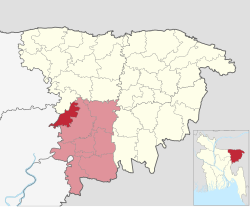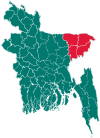Ajmiriganj Upazila
Ajmiriganj
আজমিরিগঞ্জ | |
|---|---|
 | |
| Coordinates: 24°32.8′N 91°15′E / 24.5467°N 91.250°E | |
| Country | |
| Division | Sylhet |
| District | Habiganj |
| Area | |
• Total | 223.98 km2 (86.48 sq mi) |
| Population | |
• Total | 126,324 |
| • Density | 560/km2 (1,500/sq mi) |
| Demonyms | Ajmiriganji, Ajmirigonji |
| Time zone | UTC+6 (BST) |
| Postal code | 3360[2] |
| Website | ajmiriganj |
Ajmiriganj (Bengali: আজমিরিগঞ্জ, is an upazila of Habiganj District in the Division of Sylhet, Bangladesh.[3]
History
[edit]In 1254, the Governor of Bengal Malik Ikhtiyaruddin Iuzbak invaded the Azmardan Raj (present-day Ajmiriganj). He defeated the local Raja. This was long before the Conquest of Sylhet in 1303.[4]In the 1800s, a Sufi saint who was stationed at the Ajmer Sharif Dargah of Moinuddin Chishti, migrated to modern-day Ajmiriganj. His name was Syed Ishaq Chishti, and the locals referred to him as Ajmiri Baba (Baba of Ajmer). After the death of Ishaq, a government gazette notified that Abidabad thana would be renamed Ajmiriganj (Ganj of Ajmiri) in honour of Ishaq in circa 1907.[5] Ajmiriganj amalgamated Bir Charan Govt Pilot High School was established in 1930. In 1983, Ajmiriganj thana was turned into an upazila. The names were changed from Aijadam > Ajmardan > Aijmadam > Abidabaad > Ajmiriganj.
During the Bangladesh Liberation War of 1971, an eighteen hour long encounter between the freedom fighters and the Pakistan Army took place on 16 November. 11 innocent villagers as well as freedom fighter Jagat Joity Das were killed.
Geography
[edit]Ajmiriganj is located at 24°32′50″N 91°15′00″E / 24.5472°N 91.2500°E. It has a total area of 223.98 km2. Ajmiriganj Bazar (main town), on the other hand, consists of 2 mouzas, with an area of 5.73 km2. The town has one Dak-Bungalow and a number of buildings dating from as early as the 1800s; some financed by the Maharaja of Tripura.
Demographics
[edit]| Year | Pop. (000) | ±% |
|---|---|---|
| 1981 | 76 | — |
| 1991 | 87 | +14.5% |
| 2001 | 99 | +13.8% |
| 2011 | 114 | +15.2% |
| 2022 | 126 | +10.5% |
| Source: Bangladesh Bureau of Statistics[6] | ||
According to the 2011 Census of Bangladesh, Ajmiriganj Upazila had 21,293 households and a population of 114,265. 35,070 (30.69%) were under 10 years of age. Ajmiriganj had a literacy rate (age 7 and over) of 37.06%, compared to the national average of 51.8%, and a sex ratio of 1018 females per 1000 males. 14,900 (13.04%) lived in urban areas.[6][8]
Administration
[edit]Ajmiriganj Upazila is divided into Ajmiriganj Municipality and five union parishads: Ajmiriganj, Badalpur, Jolsuka, Kakailsao, and Shibpasha. The union parishads are subdivided into 68 mauzas and 133 villages.[6]
Ajmiriganj is part of the Habiganj-2 constituency in the Bangladesh Parliament.
See also
[edit]References
[edit]- ^ National Report (PDF). Population and Housing Census 2022. Vol. 1. Dhaka: Bangladesh Bureau of Statistics. November 2023. p. 404. ISBN 978-9844752016.
- ^ "Bangladesh Postal Code". Dhaka: Bangladesh Postal Department under the Department of Posts and Telecommunications of the Ministry of Posts, Telecommunications and Information Technology of the People's Republic of Bangladesh. 20 October 2024.
- ^ Chanda, Jiban Kumar (2012). "Ajmiriganj Upazila". In Sirajul Islam; Miah, Sajahan; Khanam, Mahfuza; Ahmed, Sabbir (eds.). Banglapedia: the National Encyclopedia of Bangladesh (Online ed.). Dhaka, Bangladesh: Banglapedia Trust, Asiatic Society of Bangladesh. ISBN 984-32-0576-6. OCLC 52727562. OL 30677644M. Retrieved 2 January 2025.
- ^ Stewart, Charles (1813). The History of Bengal. London.
- ^ "Ajmiriganj Upazila Background". Ajmiriganj Upazila (in Bengali).
- ^ a b c "Bangladesh Population and Housing Census 2011 Zila Report – Habiganj" (PDF). bbs.gov.bd. Bangladesh Bureau of Statistics.
- ^ Population and Housing Census 2022 - District Report: Habiganj (PDF). District Series. Dhaka: Bangladesh Bureau of Statistics. June 2024. ISBN 978-984-475-227-6.
- ^ "Community Tables: Habiganj district" (PDF). bbs.gov.bd. Bangladesh Bureau of Statistics. 2011.

